Pethia stoliczkana
SynonymsTop ↑
Barbus stoliczkanus Day, 1871; Puntius stoliczkanus (Day, 1871)
Etymology
Pethia: the generic vernacular name for small cyprinids in the Sinhala language.
stoliczkana: named for Moravian zoologist Ferdinand Stoliczka (1838-1874) who worked in India for a number of years.
Classification
Order: Cypriniformes Family: Cyprinidae
Distribution
Appears to be widely distributed from Manipur state in northeastern India, throughout much of Myanmar and Thailand as far as western Laos.
Records show occurences in various rivers including the Ayeyarwady, Chindwin, Ataran, Mae Klong, upper Mekong, and upper Chao Phraya.
Habitat
Mostly inhabits shady, flowing streams and tributaries rather than main river channels or standing water bodies.
Such headwaters are well-oxygenated with clear water, a substrate comprising sand, gravel, rocks, boulders and patches of leaf litter with a rich biofilm normally carpeting solid surfaces.
Submerged driftwood and the roots of marginal vegetation are also typical features while aquatic plants from genera such as Cryptocoryne and Pogostemon grow in stiller parts of these well-oxygenated habitats.
It occurs sympatrically alongside numerous other fishes. For example in the upper Ataran basin, Thailand, other species include Parambassis pulcinella, Botia kubotai, Acanthocobitis pictilis, Schistura maepaiensis, Homaloptera modesta, Syncrossus berdmorei, Pangio fusca, Microdevario kubotai, Crossocheilus burmanicus, Akysis vespa, Glyptothorax dorsalis, Amblyceps caecutiens, Batasio feruminatus, B. dayi, Caelatoglanis zonatus, Psilorhynchus robustus, and Tetraodon cutcutia.
Maximum Standard Length
45 – 50 mm.
Aquarium SizeTop ↑
Base dimensions of at least 75 ∗ 30 cm or equivalent are required.
Maintenance
Choice of décor is not especially critical though it tends to show better colouration in a heavily-planted set-up with a dark substrate.
The addition of some floating plants and driftwood roots or branches to diffuse the light entering the tank also seems to be appreciated and adds a more natural feel.
Filtration does not need to be particularly strong though it does seem to appreciate a degree of water movement and will also do well in a hill stream-type set-up.
Water Conditions
Temperature: 18 – 26 °C
pH: 6.0 – 7.5
Hardness: 18 – 268 ppm
Diet
Wild fish are foraging omnivores feeding on diatoms, algae, organic detritus, small insects, worms, crustaceans, and other zooplankton.
In the aquarium it’s easily-fed but the best condition and colours offer regular meals of small live and frozen foods such as bloodworm, Daphnia, and Artemia alongside good quality dried flakes and granules, at least some of which should include additional plant or algal content.
Behaviour and CompatibilityTop ↑
Generally very peaceful making it an ideal resident of the well-researched community aquarium.
Fishes inhabiting similar biotopes in nature, especially comparably-sized, open water-dwelling cyprinids perhaps constitute the best choices but other potential options include balitorid, cobitid, and nemacheilid loaches as well as benthic cyprinids such as Crossocheilus and Garra species.
Try to buy a mixed-sex group of at least 8-10 specimens, include other schooling fishes to provide security, and you’ll be rewarded with a more natural-looking spectacle.
The interaction between rival males is fascinating to watch and they will display their best colours when competing for female attention or hierarchical position.
Sexual Dimorphism
Adult males are noticeably slimmer and more colourful than females, especially the unpaired and ventral fins.
Reproduction
Like most small cyprinids Pethia spp. are egg-scattering free spawners exhibiting no parental care.
When in good condition they will spawn often and in a mature aquarium it’s possible that small numbers of fry may start to appear without intervention.
However if you want to maximise yield a more controlled approach is required.
The adult group can still be conditioned together but a smaller aquarium should also be set up and filled with mature water.
This should be very dimly lit and the base covered with some kind of mesh of a large enough grade so that the eggs can fall through but small enough so that the adults cannot reach them. The widely available plastic ‘grass’-type matting can also be used and works well, as does a layer of glass marbles.
Alternatively filling much of the tank with a fine-leaved plant such as Taxiphyllum spp. or spawning mops can also return decent results.
The water itself should be of slightly acidic to neutral pH with a temperature towards the upper end of the range suggested above, and an air-powered sponge filter or air stone(s) should also be included to provide oxygenation and water movement.
When the adults are well-conditioned and the females appear gravid one or two pairs should then be introduced, and spawning should take place the following morning.
An alternative is to spawn the fish in a group with half a dozen specimens of each sex being a good number, although a larger aquarium may be necessary.
In either situation the adults will probably eat the eggs given the chance and should be removed as soon as any are noticed.
These should hatch in 24 – 48 hours with the fry free swimming around 24 hours later.
They should be fed on an infusoria-grade food for the first few days until large enough to accept microworm, Artemia nauplii, or suchlike.
NotesTop ↑
This species is confused with P. ticto in much of the available literature and the two are sometimes listed as synonymous with one another, with P. ticto often taking precedence.
Although some populations of the two possess a comparable colour pattern (there are reports of a P. ticto variant from the south of West Bengal state in India with a red, black-flecked dorsal-fin, for example) they do not occur in the same waters in nature and can be distinguished by examining the lateral line which is complete in P. stoliczkanus but incomplete in P. ticto.
P. stoliczkanus is further diagnosable via the following combination of characters: maximum head width 55-66% of head length; last simple dorsal-fin ray short, spinous, and finely serrated posteriorly with 12-16 serrae; spine length 16-20 % SL and 58-65.4% HL; lateral line complete with 19-23 pored scales, reaching at least to caudal peduncle; 18 preanal scales; presence of an oblong-shaped black marking above the pectoral-fin and a similarly-coloured blotch on the 17th-19th lateral line scales; two black bands on dorsal-fin, one of which is incomplete and covers the membrane of the 3rd-5th branched rays and another at the margin of the branched rays.
Wild populations can vary somewhat in colour pattern which adds further confusion in some cases with specimens from Thailand in our images lacking black bands in the dorsal-fin, for example.
The form from Mandalay division in Myanmar is generally considered the most attractive by hobbyists and is sometimes sold as ‘Puntius sp. ‘pearlscale’.
It was formerly included in the Puntius conchonius ‘group’ of closely-related species alongside P. ater, P. bandula, P. conchonius, P. cumingii, P. didi, P. erythromycter, P. gelius, P. khugae, P. macrogramma, P. manipurensis, P. meingangbii, P. nankyweensis, P. nigripinnis, P. nigrofasciatus, P. padamya, P. phutunio, P. punctatus, P. reval, P. shalynius, P. thelys, P. tiantian, and P. ticto, but all of these were moved to the new genus Pethia by Pethiyagoda et al. (2012), as were P. melanomaculata, P. pookodensis, P. muvattupuzhaensis, P. ornatus, and P. yuensis.
‘Puntius‘ narayani was not moved to the new genus and is currently of uncertain generic placement since it uniquely possesses 9 branched dorsal-fin rays and 6 branched anal-fin rays.
Pethia species are defined by the following combination of characters: rostral barbels absent; maxillary barbels minute or absent; possession of a stiff, serrated last unbranched dorsal-fin ray; presence of a black blotch on the caudal peduncle, and frequently, black blotches, spots or bars on the side of the body; infraorbital 3 deep and partially overlapping the preoperculum.
The genus Puntius was viewed as a polyphyletic catch-all containing over 100 species of small to mid-sized cyprinid for a number of years until Pethiyagoda et al. (2012) published a partial review covering South Asian members.
The majority of sub-Himalayan Puntius species were reclassified and new genera Dawkinsia, Dravidia, and Pethia erected to accomodate some of them, with the remainder either retained in Puntius or moved to the existing Systomus assemblage, though the definition of the latter was altered meaning some Southeast Asian species formerly placed there are no longer members.
It subsequently became clear that the name Dravidia was preoccupied by a genus of flesh fly, therefore the replacement name Haludaria was made available by Pethiyagoda (2013).
No species from Indochina, China, or Indonesia were included in the study meaning a significant number of former Puntius are currently classed as incertae sedis, i.e., of uncertain taxonomic placement, and this also applies to a number of South Asian species of unresolved status.
They’re perhaps best referred to as ‘Puntius‘ for the time being whereby the genus name is surrounded by quotation marks to denote its questionable usage, and that is the convention used here on SF at the moment.
References
- Kullander, S. O. and F. Fang, 2005 - Copeia 2005(2): 290-302
Two new species of Puntius from northern Myanmar (Teleostei: Cyprinidae). - Kullander, S. O. and R. Britz, 2008 - Electronic Journal of Ichthyology, Bulletin of the European Ichthyology Society 2: 56-66
Puntius padamya, a new species of cyprinid fish from Myanmar (Teleostei: Cyprinidae). - Linthoingambi, I. and W. Vishwanath, 2007 - Zootaxa 1450: 45–56
Two new fish species of the genus Puntius Hamilton (Cyprinidae) from Manipur, India, with notes on P. ticto (Hamilton) and P. stoliczkanus (Day). - Pethiyagoda, R., 2013 - Zootaxa 3646(2): 199
Haludaria, a replacement generic name for Dravidia (Teleostei: Cyprinidae). - Pethiyagoda, R., M. Meegaskumbura, and K. Maduwage, 2012 - Ichthyological Exploration of Freshwaters 23(1): 69-95
A synopsis of the South Asian fishes referred to Puntius (Pisces: Cyprinidae).

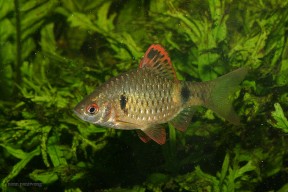
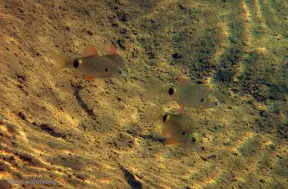
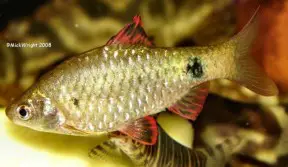
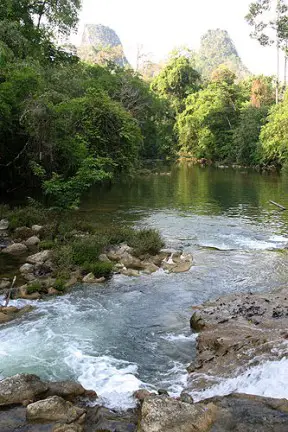
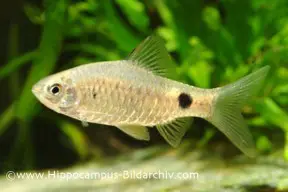
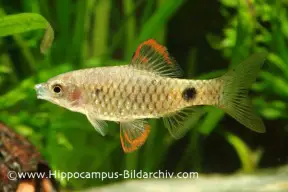
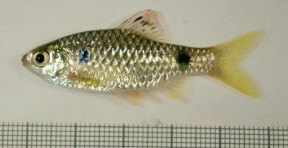
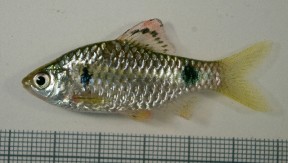
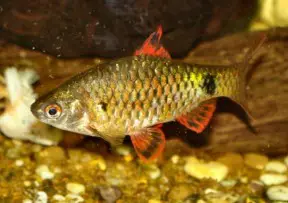

May 27th, 2015 at 10:14 am
https://scontent-lhr3-1.xx.fbcdn.net/hphotos-xft1/v/t1.0-9/1513338_965045740203089_3721194088308659338_n.jpg?oh=b69fa24b404836d0ce090a9a79d75a1d&oe=56029B54
I’m sure the fish in this pic by Ralf Britz is different to the fish in the pics by Michael Wright , I’ve just managed to find a group of the fish in Ralfs pic and they seem far deeper and quite different in behaviour too ?